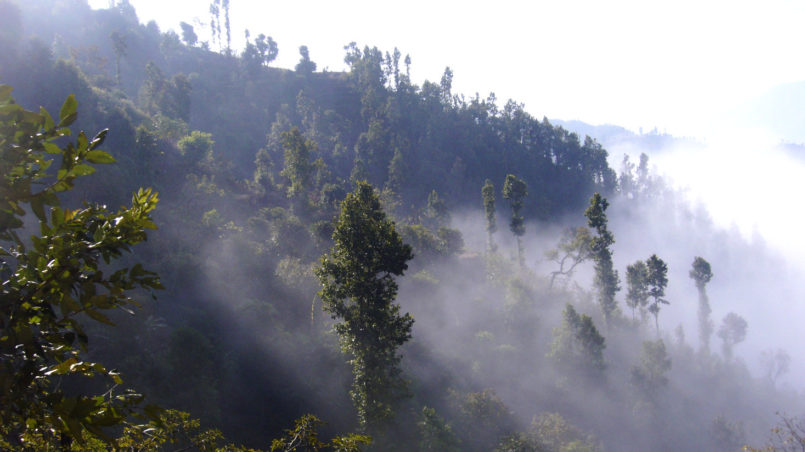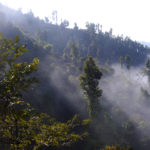“King of the Forest” – the Struggles of the Rautes

In the first part of my series (The Last Living Nomads of Nepal: Rautes), I introduced the reader to the last living nomads in Nepal. Now in this second part, I would like to tell you more about the Rautes’ lifestyle, about their struggle in the forest, their culture, and traditions and the reason why they are still in the forest.
Rautes survive by hunting, gathering, and bartering. They are very clever people and only hunt Langur and Macaque monkeys. They make special nets or wooden Valas to hunt monkeys. Vala in Nepali refers to a long, thin, pointed rod-like weapon especially used to kill wild animals like monkeys.
In the Rautes’ culture, only males are allowed to hunt. They gather various types of edible roots, fruits, grasses and leaves from the forest like wild yams, air potatoes, jungle vine, and berries. They eat fish but they don’t go fishing themselves. Rautes are not interested in hunting birds and other animals except the species of monkeys mentioned above. They never drink water from ponds, lakes, hand pumps, wells, or rivers. They only drink only the water from natural springs.
Rautes are very famous for their art of carving wood, which has a long tradition in their culture. The wooden receptacles designed by them are so durable that they last for centuries. This is one of the major ways in which the Rautes are fully independent and it has survived from generation to generation. The art of carving wooden products is handed to each consecutive generation from father to son. All the wooden products are artistically carved by hands.
Wooden products in their community have also played a major role in continuing the legacy of the Rautes’ culture. The major reason why they cut down trees is to make these wooden products. Rautes design wooden boxes with different shapes, sizes, and structures for food grains and trade them in exchange for iron, cloth, food grains, and jewellery. They never beg or accept food or materials for free. This corresponds to a belief in their culture that one can struggle but not beg. They never sell other forest products, bush meat or medicinal plants for money or food products.
In the Rautes’ culture, females are not allowed to speak with outsiders, especially with males. Only males are allowed to do so. In the Rautes’ community, there is one leader, who leads the entire community. The leader is called Mukhiya, Man Bahadur or Kaji who is elected by all the members of the community who have to obey and follow the instructions of their leader.
Living a nomadic way of life for the Rautes is similar to walking on a road of thornes. They have to tackle many problems while living in the forest. They are often the prey of dangerous wild animals such as tigers, bears, and wolves. They have to struggle to hunt and make the wooden crafts. They have to walk for several days or hours, barefoot, to sell their wooden products to neighbouring communities. Rautes are highly discriminated against by many villagers and communities in Nepal. They are not allowed to chop down trees, which is their major way of existence.
Although Rautes don’t use modern methods of medicine and treatment, nowadays Rautes are slowly becoming attracted towards medicine and money. Mostly they use medicinal herbs for treatment when they are injured or fall sick. Rautes have also been urged by the Nepali government to come into mainstream life but they refuse to give up their nomadic way of life. They just want to be allowed to live in their forest life freely and to use forest trees as they wish.
Taking the Rautes’ life into consideration, the Nepali government also provide a monthly allowance of Nrs. 1,000 (approx. $ 11) to every individual in their community. At Nepal’s largest festival, Dashain, Rautes are provided with an allowance of Nrs. 10,000 (§ 100) per family to celebrate the festival. The chief district officer of the district where they are found to be dwelling provides that allowance to them every year. Rautes use that money on alcohol, tobacco, cigarettes and to buy food grains.
Several organizations like Contemporary Vision Nepal, National Foundation for Development of Indigenous Nationalities etc. are working for the development, promotion, and preservation of the Rautes’ communities in Nepal. Contemporary Vision Nepal is the private news media organization which is doing its best to promote their products in Nepalese markets. Attempts are being made to replace the cheap and decorated plastic products found at markets with goods produced by the Rautes. Contemporary Vision Nepal also make videos and documentaries on the Rautes, their culture and work with the aim of raising awareness.
The existence of the Rautes’ population in Nepal has become the most valuable heritage of Nepal. They are the last surviving nomads of Nepal. Many foreigners come to Nepal to study them. Although I can’t say that the Rautes have to be allowed to live their life as they wish or that they must be turned into a modern community, what I can say is that they are a valuable treasure living in Nepal. We should cooperate with them and help them to survive.
Credits
| Image | Title | Author | License |
|---|---|---|---|
 |
00-Mountain-Nepal | Elisa Steininger | CC BY-SA 4.0 |
